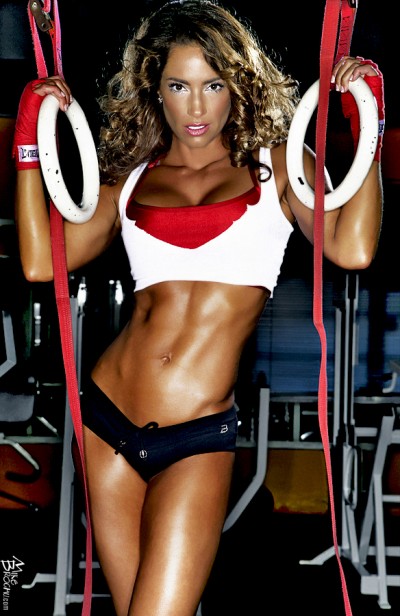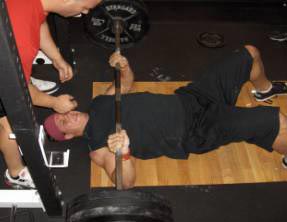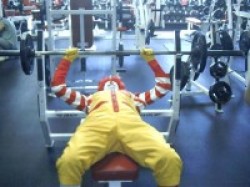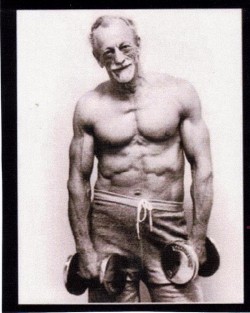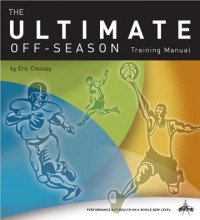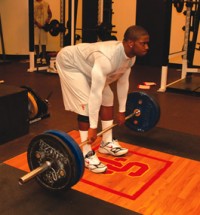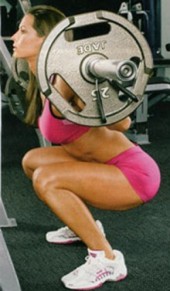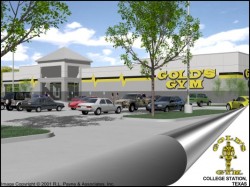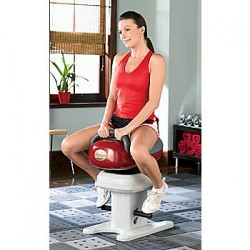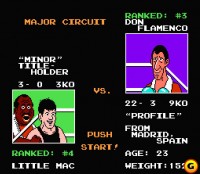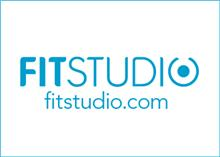The War on Fat Loss
November 1, 2010 by danny · Leave a Comment
I had a new article published last Friday. My friend Marci Nevin and I did this one together. I handled the training portion and she tackled the nutrition side. I know many of are going to have a weight loss/fat loss goal coming up as New Year’s resolutions are right around the corner. Hopefully this piece will motivate you and help you get to your goals…
“The War on Fat Loss“
How to Get Athletes Faster
October 13, 2010 by danny · Leave a Comment
As a strength coach and basketball coach I’ve had many parents ask me over the years; “how do I get my son/daughter faster?” More often then not, these well-intended parents/coaches figure the best way to improve speed is to have the young athletes do agility drill after agility drill. But they leave out a VERY important component to improving speed – strength training. Both Eric Cressey and Mike Boyle do a great job of addressing the importance of getting stronger in the quest to becoming faster. You can check them out here…
As Coach Boyle points out; ”The best solution to slow feet is to get stronger legs.”
If you are a parent, or a coach of a sport, and the “sciency” type of stuff that Mr. Cressey & Boyle are talking about has you a little confused, just know that the more force you are capable (by getting stronger through weight training) of putting into the ground, the faster you are going to be able to run, the quicker you are going to be able to stop, and the higher you are going to be able to jump. And I couldn’t agree more with Eric – many sport seasons go year around these days (i.e. a basketball player or volleyball player that has their regular season, then it’s off to spring league, followed by summer league, followed by fall league. And then mix in a few camps in the summer, and a number of open gyms… as you can see, it is NON-STOP!). I think it’s fair to say that these athletes are spending more than enough time working on agility. Their non-playing time would be better spent getting stronger, as opposed to going to “speed” camps in which the coaches/trainers focus on movement training – where the majority of what they do is more agility drills, with no weight training.
If you read Eric and Mike’s posts, and my thoughts from above, I’m pretty confident that you are “sold” on how important strength training is to becoming a faster athlete. But just in case you are still not buying it, think about some of the fastest athletes in the world… sprinters in track and “skill” players in football (defensive backs, running backs, receivers). These are athletes that are moving some serious weight in the weight room!
So, if you are a parent or coach to an athlete(s) and do not have access to a qualified strength coach in your area, where do you begin? The biggest advice I can give you is to keep it simple for now, work on form, and focus on big, compound movements with free weights (i.e. lunges rather than leg extensions) Here is a good place to help you get started – http://bit.ly/cj4T3v. And don’t be thrown off by the title of the article. This would be a good place to start for most young athletes. Now go get some people stronger!
High Volume Training while “Bulking”
I just started a new training block, as well as a shift in my physique goals. As we say goodbye to summer, having ripped abs is no longer priority numero uno. I made a facebook post last week saying that I am starting “bulking season.” Then, Mark Young yelled at me. What an a-hole, can’t he let me gain weight in peace!?! Just kidding, he didn’t really yell at me. He just stated that he is not a fan of the word ”bulking,” when gaining size becomes a trainees priority. And I can see where he is coming from. This is true because for many people, “bulking” season simply equals an excuse to become fat.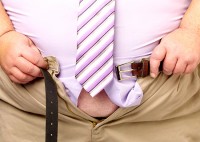 Just because the number on the scale goes up, it doesn’t mean that you are putting on quality weight. Mark said he prefers that it was called “lean mass accretion season.” Ha, that is funny! It is a actually true, as adding lean mass rather than fat mass is what we are looking for. I’m just not so sure that phrase will be one that sweeps the nation anytime soon. Good try though, Mark!
Just because the number on the scale goes up, it doesn’t mean that you are putting on quality weight. Mark said he prefers that it was called “lean mass accretion season.” Ha, that is funny! It is a actually true, as adding lean mass rather than fat mass is what we are looking for. I’m just not so sure that phrase will be one that sweeps the nation anytime soon. Good try though, Mark! ![]()
Anyway, I accept that some fat mass will accumulate with my attempt to add muscle this lean mass accretion season (there you go Mark, it’s already catching on). But my main goal is to add muscle without becoming a fat, softy. In going from six pack emphasis to hypertrophy (muscle gain) emphasis, I’m taking a bit of a different approach than I usually do. To gain muscle, we must have a balance of intensity (heavy weight that is close to our 1 rep max) and volume (the amount of reps in a session). But all of the volume in the world is not going to do much for you if you haven’t spent many years under the bar working on your strength. In other words, if I’m going to do a high volume of bench pressing in a session (lets say 8 X 12), but my 1 RM (rep max) is only 95 pounds, I have no right to go to a high volume approach.
The light weight for 96 reps (8 X 12) won’t do a thing for me in attempt to add size to my pecs, shoulders, and triceps. So, if you are newer to training, spend some time (years) getting stronger before you ever think about using a high volume approach in your training.
With the said, my idea of high volume is different than what some others may consider high volume training. My friend and Physique Coach, Dr. Clay Hyght and I have had a number of discussions about the benefits of high volume training. Dr. Clay is convinced that to achieve as much as size as possible, high volume training must be used (or at least incorporated throughout the training year). And I’ve also seen some of the programs written by another Coach that I respect, John Romaniello. I usually have to do a double-take and I say to myself, “wow, that is a HUGE amount of sets/reps!” So, when I wrote up my current program last week, I had to keep telling myself, “more, more, more,” in regards to amount of sets/reps I programmed in for myself. Again, high volume to me is a little different to some of these other successful coaches. But I decided that I’m going to go for it. And all of the calories I am taking in will go along well in turns of helping with recovery.
A few of you have asked me what the program looks like. I don’t want this post to drag on too long, so I’ll be back in a couple days to show what the program entails. Maybe I’ll include a few pictures in a couple weeks as well, so we can see if all these calories and reps are doing me right. Stay tuned…
Should Your Max Always Be Your True Max?
August 23, 2010 by danny · Leave a Comment
The other day I worked up to a 2 rep max (RM) with trap bar deadlifts. After I finished the 2RM, I could have “easily” (ok, not easily, but I certainly left some weight on the table) added more weight and gotten a higher 2 RM for the day. And no, I’m not acting like the typical internet forum hero and making claims that have no truth. Here’s the video for proof…
That is 405 pounds X 2. *** While certainly no world record, it is not bad since I currently weight just under 160 pounds (“bulking season” is just around the corner however ![]() ) After I finished rep #2, I felt as if I could have done another 2-3 reps, or done another set and added at least another 20 pounds to the bar and continued working up to my 2 RM for the day. I decided to do neither. At this point in my life, in my opinion, it is not worth it. I’m 34 now, and my main goal is to have a buff, healthy body. If I were to continue working up to a higher weight, only to round my lumbar spine and herniate a disk, I’d be very pissed at myself. If I continued to work up to a heavier weight for the next 4-5 weeks in my program, and hit 450 X 2, or 475 X 1 (or whatever), would I really be healthier and more buff? Maybe, maybe, maybe a touch bigger. Every exercise we do in the weight room has a risk:reward attached to it. Going for a number considerably bigger than 405 X 2 on deadlifts to me, is riskier than what the reward would bring. When doing deads, my goal is to go as heavy as possible while having perfect, or near perfect form on every rep. If you look at the video, I think my form is good for lifting a weight that is more than 2.5 times heavier than I am. But it is not perfect. (And how much sloppier would it get if I were to continue working up to a higher max?) I slightly extend my neck as I lift the bar off the floor. And my hips rise SLIGHTLY before my shoulders but overall, I’m happy with the lift. Certainly much better than many deadlift attempts that you’ll see out there…
) After I finished rep #2, I felt as if I could have done another 2-3 reps, or done another set and added at least another 20 pounds to the bar and continued working up to my 2 RM for the day. I decided to do neither. At this point in my life, in my opinion, it is not worth it. I’m 34 now, and my main goal is to have a buff, healthy body. If I were to continue working up to a higher weight, only to round my lumbar spine and herniate a disk, I’d be very pissed at myself. If I continued to work up to a heavier weight for the next 4-5 weeks in my program, and hit 450 X 2, or 475 X 1 (or whatever), would I really be healthier and more buff? Maybe, maybe, maybe a touch bigger. Every exercise we do in the weight room has a risk:reward attached to it. Going for a number considerably bigger than 405 X 2 on deadlifts to me, is riskier than what the reward would bring. When doing deads, my goal is to go as heavy as possible while having perfect, or near perfect form on every rep. If you look at the video, I think my form is good for lifting a weight that is more than 2.5 times heavier than I am. But it is not perfect. (And how much sloppier would it get if I were to continue working up to a higher max?) I slightly extend my neck as I lift the bar off the floor. And my hips rise SLIGHTLY before my shoulders but overall, I’m happy with the lift. Certainly much better than many deadlift attempts that you’ll see out there…
Your Goals, Your Call
If you think I’m being a big wuss for not really caring too much about not getting my deadlift up considerably higher, that is fine. And if your goal is to deadlift as much weight as humanly possible, I am completely cool with that. I get it. Lifting heavy weight is definitely an important component to having a muscular body. That is why I have worked up to deadlifting over 400 pounds. But I am not competing in powerlifting and again, adding some lbs to the bar in this lift won’t do a ton to making me more jacked. Even Eric Cressey, a former competitve powerlifter who has a deadlifted over 600 pounds has stated this in an article…
Category 1: Weekend warriors who deadlift to improve functional capacity and correct or prevent imbalances.
Category 2: Athletes who deadlift to improve performance and bulletproof themselves against injury.
Category 3: Powerlifters who deadlift to get better at deadlifting.
Logically, I’m willing to take more chances in category #3 than I am in #2, and certainly #1. Weekend warriors don’t get aggressive loading parameters (singles over 90%). And while athletes might get to pull heavy singles, they only get to do so in a controlled environment (elevated trap bar deadlifts, pulls against chains).
A veteran athlete would blur the line between #1 and #2, and a more resilient up-and-coming athlete would be more of a “true” #2.
According to Eric’s categories of deadlifting, at this point in my lifting “career,” I put myself in category #1, merging with category #2, as my competitive juices get flowing sometimes and I can’t help but “really going for it!” But I’m certainly not willing to go into category number 3 just to add a few pounds to the bar.
Other Lifts
There are plenty of other lifts out there where going ALL OUT with weight carries a much smaller risk. And on those lifts I often work up to a true max (and have my clients do the same), whether that means a 1 RM, 8 RM, or any other rep range that I am working in. For example, the other day I worked up to a 1 RM with chin-ups. I hit 100 lbs X 1…
Later on in that same training session I did some hammer curls…
If I ended up picking a weight that had me falling a little short on that chin-up (missing a lift – rarely, if ever a goal), I think my injury status would still = healthy. Same thing with exercises like curls.
Moral of the Story
I hope you don’t think I am saying that you should not try to get stronger in certain lifts, like the deadlift. Getting a big(ger) deadlift will do wonders for your physique. But with certain lifts, I want you to ask yourself how important it is to really go for a true max. While in other exercises, pushing it to a true max is probably worth it. Only you can answer the importance of what category you put each lift in within your training goals. As I get older, I get smarter and am comfortable of knowing when to hold back a touch, and when to completely go for it.
*** Like I mentioned, 405 X 2 is not a world record. But it is a world record for the most weight ever lifted while listening to John Mayer. What the hell was that!?!
How Do You Handle Adversity?
August 16, 2010 by danny · Leave a Comment
Below is an older article that I wrote. I thought it would be good for you to check out… for basketball AND non-basketball players. Like I always tell my clients, “when we are training, we’re not just building muscle, we’re building character.”
Some Thoughts on Periodization
August 10, 2010 by danny · 7 Comments
The scary P word. I’ve known many people that would prefer to spend the entire day at the dentist rather than talk (or think about) periodization. Most people just want to go lift and turn their brain off for one hour, 3 to 4 days out of the week. To a certain point, I can see why this is the mind-set of many trainees. After all, you don’t have to look very hard to hear one trainer make a particular suggestion (no matter what the topic – reps, sets, form, tempo, etc), only to read 5 other trainers give 5 different opinions. Well, I’m here to help simplify.
I’m not going to get into a 12-month periodization plan that involves in-season, early off-season, general off-season, and pre-season planning. If you train athletes and are looking for a great resource, check out Eric Cressey’s, “The Ultimate Off-Season Training Manual.” This is a must for your coaching library!
For the purposes of this post however, I’m not going to be giving my thoughts on periodization for athletes (although some of this information can be useful if you are an athlete or train athletes). I’ll be speaking more to the trainee just looking to improve his or her health and physique.
-For the most part, you don’t need to plan more than a month in advance. Don’t get me wrong, I do think it is smart to look down the road for more than a month at what you are looking to accomplish. For example, I don’t recommend doing three straight blocks focusing on hypertrophy, then move on to a fat loss phase for a month, only to go right back into a hypertrophy phase. Just randomly throwing a fat loss block in there doesn’t really fit, and probably would hurt your chances to maximally put on muscle. But the bottom line, don’t sit on your butt for a month straight trying to figure out the perfect macrocycle when you could have been in the gym getting closer to your goals during that time.
-Psychology/motivation is huge! Yeah, full body (FB) training is great for fat loss. But let’s say that you just spent your last two training blocks (8 weeks total) training FB and you CAN’T STAND the thought of going into another FB block. After all, it can be very draining to know that you are going to be doing a deadlift or squat variation AT EVERY SINGLE session, EVERY SINGLE week. Even if a body part split may be less than perfect for fat loss purposes, it can be very motivating to know you are about to head to the gym, and NOT have to squat or deadlift. “Today’s back and biceps? Sweet, I can’t get to the gym soon enough!” Be sure to keep this in mind as you head into your next training block (or a block sometime down the line).
-I’ve tried just about every combination of fluctuating volume over the course of a training block (4 weeks). I’ve tried the Cressey Performance way (at least this is the way they typically set up a block the last time I checked), which is;
- Week 1 – High Volume
- Week 2 – Medium Volume
- Week 3 – Very High Volume
- Week 4 – Low Volume (Deload)
Then, there is a the Results Fitness way (again, last time I checked);
- Intro Week
- Base Week
- Overload Week
- Shock Week
Coach Alwyn Cosgrove sets it up so each week is harder than the next. Essentially, you build up each week so by the last week you are hitting your highest loads of the block and maybe setting some PR’s in the process. Then the next week you will start a new block, with the lowest volume (basically, your deload week).
There are other ways to set up this week-by-week fluctuation in volume/intensity. But right now, here is what I have been doing for some time now…
- Week 1 – Intro Week; Volume is lower than week 2 and 3 and I stay a little further from failure on this week. Basically, when bar speed is slower than rep 1, I stop the set. This isn’t set in stone, as I’m not really too scared about overtraining if I am doing some curls. So if I “grind” out a few reps on certain exercises, I’m cool with it. But I doubt you’ll see me doing multiple sets to failure with front squats, for example.
- Week 2 – Volume goes up and I may have a few more of the “grindy” reps than on week one. Still, I never go ’til I purposefully miss a rep
- Week 3 -Similar to week 2
- Week 4 – Deload week; volume is similar to week 1, maybe even a little lower (for the females, check out this article that I wrote awhile back – something to think about)
Justification
When I was doing the Cressey Performance set-up, I personally didn’t like to go into a high volume week when starting a new block. In week one of a new block, you are switching up exercises, sets, and reps. This greatly increases the chances of soreness. And then add to the fact that it is high volume week, I found this to be a recipe to have me limping around for days (especially on exercises that tend to make us sore anyway. i.e. RDLs). This is why I have since switched to week 1 being a low(er) volume week. I figure, I am going to be sore anyway on week 1, why make it even worse.
The Results Fitness way is great, but here I found I didn’t like the psychological aspect real well. By the time week 4 of the same program roles around, I’m actually getting a little bored. The last thing I want to do is make this my hardest week. A slight mental break, by going low(er) volume, is nice here. Plus, it helps to keep my feeling fresh going into the new block in the week to come.
For the above reasons, I’ve settled in on liking the approach that I am currently using. I am also a fan of “cybernetic periodization” (going by feel). So, if week 2 or 3 calls for 5 x 3, but I am feeling like superman, I may do 7 sets of 3 that week. On week’s 1 & 4 I try to fight this temptation as I don’t think my superman-like feeling would be worth it as it would negatively effect the week to come (risk:reward = not worth it). I must say however, that although I do like cybernetic periodization, I am not a big fan of just winging it (although on rare occasion this can be good psychologically… there’s that word again). I am fan of having a training template, but giving yourself a little freedom to adjust according to how you are feeling on that particular day.
I definitely do NOT think that the Cressey Performance and Results Fitness plans are wrong. You can probably look at ANY 4-week set-up and find something imperfect about it - including the model I am currently using. When I work with a client long enough, quite often I will have him/her try a few types of 4 week set-ups. I will go over the potential pros and cons with them, and get their thoughts after trying each plan. Together we then go with a plan that gets them the most fired up and motivated to train. Thus far, “my” current 4-week plan has been the most popular with my clients. This doesn’t necessarily mean anything, I’m just sayin’. ![]()
Finally, if you are reading this and are in your first year of serious lifting, you should look at most of the above as a bunch of mumbo-jumbo. BUT, I want you to save this, study it again after a year, and consider my thoughts as far as which training split to use (answer – use them all ![]() ), and which 4-week plan to go with. Remember, consider both physiological, and psychological factors. Happy planning!
), and which 4-week plan to go with. Remember, consider both physiological, and psychological factors. Happy planning!
The Coaches That Have Influenced Me The Most
August 2, 2010 by danny · 4 Comments
Then one day at Gold’s there was a flyer that was put up at the front desk. It said something like, “Cy Willson will be holding a seminar, talking about nutrition and supplementation.” I couldn’t wait to attend, as Cy had a reputation around the gym as a very smart guy. Plus, I could now get some of my questions answered, and most likely confirmed (so I thought). I pulled up a chair to listen to Cy speak. I couldn’t wait to learn a few new things, and again, confirm that my training and nutrition “plan” was pretty much on the money. By the end of the seminar, my head was spinning, and I realized that I didn’t know sh*t about sh*t! I learned a bunch of new words, like whey and casein, heard about nutrient timing for the first time, and listened to Cy dispel a bunch of myths that I didn’t even know were myths. When I walked out the door of the room the seminar was being held in, I was very frustrated, and a little embarrassed that I ever offered even a single bit of training and nutrition advice to the people that had asked me for help over the years.
At the time, Cy was writing for a website called testosterone magazine. In the seminar, he told us that we could all become experts if we started to follow it and to soak in as much of that information as possible. So I got home, hopped on the computer, and started to read some of the articles. I read articles by John Berardi, Cy, Ian King, and Charles Poliquin. And I had no idea what they were talking about. Wait, what is this “hypertrophy” word they keep bringing up? And are hormones like insulin and testosterone really that important? According to these experts, it seems like they are. But why? I just don’t get it. I started to think, maybe this whole personal training thing just isn’t for me. After all, the only reason I ever got better than D’s and F’s in school, was so that I could stay eligible for basketball. Everyone knew school and studying wasn’t really important to me. I’d much rather be lifting weights, playing basketball, or going to the beach. But I knew lifting/working out would be a big part of my life for a long time. I loved it. And I couldn’t go to the gym and “not really know what I was doing.” So I decided to buckle down and really try to learn from these people at that website. I went up to Cy at the gym and asked him if he’d meet me so I could ask him some![]() nutrition questions. He was very nice and said, “sure, no problem.” So I headed back to testosterone magazine and spent hours reading his articles, as well as articles by the other authors. I took a bunch of notes and was going to be prepared for the day when Cy and I were to meet.
nutrition questions. He was very nice and said, “sure, no problem.” So I headed back to testosterone magazine and spent hours reading his articles, as well as articles by the other authors. I took a bunch of notes and was going to be prepared for the day when Cy and I were to meet.
I still remember, I had a list of 18 questions put together for him. I thought to myself, “if I can just get Cy to help me understand these questions, I will basically have this whole nutrition thing down.” And let me tell you, these questions weren’t the most advanced questions by any means. The average question looked something like this; “in one article, it says that beef is good for you, but in John Berardi’s article, he says that we should avoid burgers. What’s the deal?” Cy said something like, “John is probably referring to greasy burgers, like the ones you find at McDonald’s. If you eat a lean cut of beef, it is good for you. Especially if it is grass fed.” I was like, “great, I can check that off of my list. Only 17 questions left and I will know all I ever need to know!” Anyway, as I got deeper into the field, I found out that the more I learned, the more I realized I didn’t know. It was about at this time, that I became obsessed with learning as much as I could. So much so that I quit teaching and started training full time. My dad was shocked. For him (back in middle and high school), trying to get me to turn off ESPN in order to get me to study, was like pulling teeth. And now, I was spending more time with my face in the books than ever before… and then some.
My journey as performance coach, personal trainer, strength coach (whatever you want to call me) began with Cy Willson, and it continues today. Below, are the people that have influenced me the most. They are grouped in chronological order. The first group is the first wave of experts that I learned from early on. As you move down the page, you’ll see the next wave of people that I learned from, all the way down to the most recent coaches. Just because Charles Poliquin (for example) is in the first group, it doesn’t mean that I don’t still learn from him. He is listed in the first group only because that is the time when I first started reading his work.
Cy Willson – you heard about Cy above. Even know that I’ve thanked him for helping me learn in my early days as a trainer, I don’t think he knows how thankful I truly am for all of his help. Besides attending two of his seminars at Gold’s, and that time that he met up with me to help answer those 18 questions, he also responded to every one of the countless e-mails that I sent him over the years. I’m VERY appreciative of this!!!
Dr. John Berardi – before Dr. Berardi had ever written a book, or was in position to influence hundreds of thousands of people, like Cy, he was answering many of the e-mails that I sent him back in the day. Cy and John really are the two that got the fire burning for me.

Ian King - Ian and Charles Poliquin were the two that first got me interested in learning all I could about weight training.
Charles Poliquin - See Ian King above.
Moving on a little later in time, to the next group of trainers that have had a huge influence on all I’ve learned over the years..
Eric Cressey – Like Dr. Berardi and Cy Willson above, Eric was very generous with helping me out early on. I definitely still learn a ton from EC today!
Joel Marion - I first read Eric and Joel’s work in the old “Ruggedmag.com” website. It is no longer a ’site, but like t-nation, I looked forward to the articles they would publish each month.
Mike Robertson – Mike did a lot of his early t-nation writing along with Eric, and I learned, and still learned a ton from him.
Dave Tate – I bought the “Westside Seminar Video” many years ago, and it exposed me to powerlifting. I belive Eric Cressey referred me to this DVD set after I e-mailed him asking him where I should go to learn more about training a powerlifter that just hired me. She went on to set many personal records and it felt great helping her out!
Christian Thibaudeau – When I first read Christian’s work I loved it. He offered info and experience from the Olympic Lifting side of things, as well as a lot of great bodybuilding info.
Chad Waterbury - While I don’t agree 100% with everything Chad has written over the years, he has made me think and I definitely incorporate some of his methodology when writing client’s programs (and my own programs).
David Barr
Mike Boyle - Anyone that cares about getting better in this field has learned a thing or 257 from Coach Boyle.
Alwyn Cosgrove - Has influenced many.
Jason Ferruggia
Dr. Clay Hyght -Dr. Clay moved to Cali. a few years ago. We started working together and became friends. As you can see, I have a large number of people listed as those who have influenced me, so I obviously don’t prescribe to only one person’s training methods. But if I was maybe starting to lean a little too far to the “train movements, not muscles” side, Clay bitch slapped me back in line. While I don’t think that strictly training movements is wrong, it’s not completely right either. To me, it is about when to bring out which tool for the client. That may be using O lifts at certain times. It may mean using a powerlifting type of template, or it may mean using “bodybuilding” training at certain times. The answers always seem to be somewhere in the middle (in any aspect of life). Which is why I wrote this article sometime back… “Change it Up and Stay Motivated”
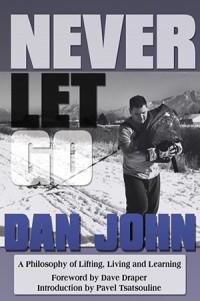
John Romaniello – I believe John was among those that were writing for ruggedmag years ago. I remember liking his work, and then didn’t hear anything from him for quite some time. Well, he’s back with a vengeance. Over the last year he has published many article and come out with a book.
Mike Roussell …
Jimmy Smith …
Nick Tumminello - Since the first NT article I read, I can’t get enough of Nick’s work. He is very smart and does a great job of clearly communicating his knowledge!
Brian St. Pierre - Great nutrition info. He gives logical reasoning for all of his opinions and never seems to go too far to one extreme or the other.
Lyle McDonald
Tony Gentilcore - I love Tony’s writing. Very informative, and very entertaining!
Gray Cook …
Mak Young…
Alan Aragon…
Bret Contreras - Bret is a going to be a name that we’ll be hearing about for years to come. And I have a feeling he’ll be on the short list of many trainers, as one of their biggest influences. If you want to build a nice booty, get to know Bret’s work.

If I had to pick just 3 or 4 from each “era” that have have influenced me the most, here’s the All-Star line-up
Danny’s “Golden Era”
Cy Willson
Dr. John Berardi
Ian King
Charles Poliquin
The First “Next Era”
Eric Cressey
Mike Robertson
Christian Thibaudeau
The, I Can’t Think of a Cleaver Name, Era
Mike Boyle
Alwyn Cosgrove
Dr. Clay Hyght
Jason Ferruggia
My Newest Breed of Influences
Tony Gentilcore
Bret Contreras
Nick Tumminello
Brian St. Pierre
I wonder what my list will look like in 2020. Thanks to everyone that has helped me over the years! I try to give as much back as I can to youngsters looking to get in the field, and/or people that are simply looking to improve their health and physique. And with the help from the people in the list above, I am now better equipped to answer the question, “bro, like what I gotta do to get some huge pecks dawg?”
Powerful Quotes
July 27, 2010 by danny · Leave a Comment
I’ve always loved a good quote. My senior year in high school I taped a handful of my favorites to my locker. I placed them there as little reminders and motivators. While there are 1000’s of great quotes, today I am going to share 5 quotes that have either been with me for years, or quotes that I have recently stumbled upon. Here they are …
-“A good listener is not only popular everywhere, but after a while he gets to know something.”—Wilson Mizner
It seems like we (probably me included at times) are so busy telling everyone all the things we “know” to be right, that we forget to shut up, listen and learn. I’m all for people that are willing to share a little of their knowledge and experience with others. In my opinion however, many would be wise to shut their traps so they can listen and learn from others. Out of all the things that I’ve done less than perfect in my time on this planet, one thing I give myself credit for is the fact that I have always listened to what my coaches (sport coaches) and other strength coaches (colleagues – many that are smarter than I) have had to say. I may not always agree with everyone 100% of the time, but I am going to hear what others have to say before I interrupt them and start to tell them why “my way” is right.
“The most important shot is the next one.” – my Dad
This quote from my dad has gone through my head above a billion times since he first said it to me. He first said it, reminding me that the last few shots I took don’t mean anything anymore. Even if I miss 4 straight, all that matters now is the next shot I take. This is true in so many aspects of life. If we mess up, move on, because there is nothing that we can do about it now. It is time to move on and give our next shot our best attempt.
“Consistency not novelty is the secret to uncommon results.”- Dr. John Berardi
Now, I don’t think JB is the creator of this quote (I could be wrong), but he is the first person I heard say it (write it). We need to stop searching for the magic potion and realize that good old fashion hard work and discipline are where it’s at. How ’bout we stop believing those stupid infomercials that promise us 6-pack abs in 14 seconds or less. “The ‘Rock and Go Exerciser’ now only $200! We promise if you buy our product, you’ll have the booty, and man of your dreams”…
“If you are so smart, why do you need my credit card?” – Jim Rome
I’ve heard Jim Rome say this numerous times when talking about the “expert” gamblers. They are notorious for telling  the radio listeners that “all you have to do is give us your credit card information, and we’ll guarantee you a 14-0 week. And don’t forget the college football play of the year!” Huh? If you could go 14-0 every week, why don’t you just go ahead and place the bets for yourself and not ask me for my cc number? Snakes! Good call Romey!
the radio listeners that “all you have to do is give us your credit card information, and we’ll guarantee you a 14-0 week. And don’t forget the college football play of the year!” Huh? If you could go 14-0 every week, why don’t you just go ahead and place the bets for yourself and not ask me for my cc number? Snakes! Good call Romey!
“Life is a game of adjustments.” - my Dad
Poppa McLarty makes it in again! If your man keeps beating you to the right, force him left. If you are getting Cs and Ds in school - study more. Get a tutor. Hang out with smart chicks. You can’t seem to lose any weight? Maybe doughnuts every morning for breakfast should be replaced with pastured eggs, old-fashioned oatmeal, and some organic blue berries. You’re a Green Bay Packers fan and your life sucks? Stop rooting for the Packers. You get the point – make the necessary adjustments in life and you’re life will be more awesome.
It’s very easy to motivate me. All you have to do is send me a motivating quote or picture, and you’ll see me sprinting to the squat rack. I hope these quotes motivate you, make you think a bit, and help make you do good stuff. Man, how did I not include that powerful quote in my high school locker? … “help make you do good stuff.” That’s deep man, deep.
Overweight Kids, Accountability, and Some Fun
July 20, 2010 by danny · 2 Comments
A have a few great blog posts to share with you today. They all deal with a BIG problem that continues to become a BIGGER problem (puns intended). The problem I am speaking of? Our kids are getting fatter and more unhealthy 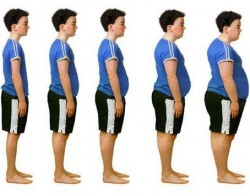 every year. The cause of the problem? Video games, TV, and more processed food. Yes, these are huge problems. But who is buying our kids the video games? Who is bringing all this crappy food home? Who is taking our kids to McDonald’s every week? See where I am getting? Us adults/parents need to step up and take some accountability as well. I could go on and on, but I’ll turn it over to a couple guys that already did a great job of writing about the overweight kid problem/parents needing to step up problem.
every year. The cause of the problem? Video games, TV, and more processed food. Yes, these are huge problems. But who is buying our kids the video games? Who is bringing all this crappy food home? Who is taking our kids to McDonald’s every week? See where I am getting? Us adults/parents need to step up and take some accountability as well. I could go on and on, but I’ll turn it over to a couple guys that already did a great job of writing about the overweight kid problem/parents needing to step up problem.
In this post, Mark simply tells it like it is. Please parents, don’t get defensive and angry at Mark. Think about what he is saying and think about what we can do to help. We (my wife and I) are far from perfect so I am not saying that we don’t have improvements to make as well. When I read this I immediately brought Carson (9 years old) over to the computer and went over this information with him and Shondra (wife). As she is the one doing most of the “kid” grocery shopping in the house. I think it helped both of them to see this article. And it helped Carson to see the nasty looking picture of what I thought was ice cream. DISGUSTING!!! My favorite quote from the article; (when talking about his daughter) “Granted, she will have the occasional treat like a home baked cookie or piece of candy every so often, but she won’t have a treat every day because a treat per day isn’t a treat, it’s a habit.”
Brian St. Pierre once again hammers home the point that we have a choice. Yes, there is fast food all over the place. Yes, a good amount of the grocery stores are filled with candy and sugar. But we don’t HAVE TO buy it. Be accountable and don’t blame others!
Overdoing It?
I hope you don’t think I am crazy. I still think we should take our kids out for pizza night. Ice cream after a big win for the baseball team? Great! All I am asking, is that this are not the staple. Every night? Every (many) meal? C’mon! Again, the problem is growing, and it’s only getting worse. Let’s all step up as parents and make some changes! ![]()
Fun!
It drives me crazy that Carson can watch the Suite Life of Zack and Cody, WWE, and Sponge Bob for hours on end. It can be like pulling teeth to get him to get outside and spend 10 minutes (yes, just 10 minutes!!!) working on his dribbling skills. I could go on and on (and I have) and tell him what most of us parents do; “Carson, back when I was your age I would get some friends together and spend hours and hours outside… pick up basketball games; tennis ball baseball; swimming at the Rockton Pool; tackle football in the back yard…..” and the list goes on. But, if all I do is pound him with, “you should be more like me” stories, I am just going to end up one frustrated person with no change in sight.
So, how ’bout the option of getting out there and playing with him? This past weekend we spent about 2 hours each day at the pool swimming. We timed eachother to see how fast we could make it from one end of the pool and back. And spent a lot of our time diving for a tennis ball into the pool… always a favorite of mine. Not sure who has more fun at this “game,” me or the kids. ![]() …
…
Yep, as a kid I played Mike Tyson’s Punch-out and loved it!
I watched WWF. I ate (and still sometimes eat) reese’s pieces. But let’s make sure our kids are not doing this all day. Make sure they are eating some fruits ‘n veggies, lean protein, and having some fun while playing outside. And remember, the best way to accomplish this may be to get out there and some fun with them!
Schtuff They Said That I Like…
July 14, 2010 by danny · 4 Comments
In my weekly blog reading, I always come across some great info. from my colleagues. So every now and then I’ll share with you some of the information that I really liked. This is information that I want to help spread to as many people as possible, as it can only help more people reach their health and physique goals.
This comes from an interview that Jason Ferruggia did with Chad Waterbury. Chad just came out with a new fat loss book called Body of F.I.R.E. In the interview, Jason Asked Chad; “What are the three biggest mistakes you see people making when trying to lose fat?“ Part of Chad’s answer; ”The first mistake is performing long duration cardio at  a low intensity. Nothing wastes muscle tissue faster than jogging for an hour. When muscles are forced to continuously contract for 45 minutes or an hour, that energy has to come from somewhere. The body is very stubborn and doesn’t want to use fat for energy because it’s much easier to break down muscle tissue instead. This is why marathon runners are skinny and weak.”
a low intensity. Nothing wastes muscle tissue faster than jogging for an hour. When muscles are forced to continuously contract for 45 minutes or an hour, that energy has to come from somewhere. The body is very stubborn and doesn’t want to use fat for energy because it’s much easier to break down muscle tissue instead. This is why marathon runners are skinny and weak.”
And then, in the comments section below a reader asked Jason; ”
“I know you’ve said in the past Jay that you don’t like mid-range stuff because humans weren’t born to run long distances. Almost all the research articles that I’ve found show the complete opposite. I have no doubt that high-intensity will get you jacked, but is it really because we’re born to do it? Is there something I’m missing?”
And Jason’s response;
“Way back in the hunter gather/ caveman days humans did two things- they walked for long durations going out to gather food and supplies needed to build shelters, and they sprinted after their prey or away from predators who were trying to eat them. They never 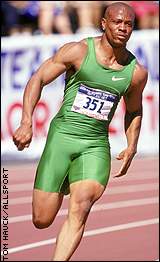 jogged for the sake of jogging or if they were migrating to another region they walked, not jogged.
jogged for the sake of jogging or if they were migrating to another region they walked, not jogged.
Yeah, you can run long distances if you want to. But it is the worst form of exercise for your body.”
I couldn’t agree more. You can see that I’ve previously written similar – check it out here and here.
Moral of the story; when getting your cardio in, keep the intensity low (like a 30 minute walk) to help burn some extra calories, contribute to speeding up the recovery process (like after a hard weight training workout), and to help preserve muscle (medium paced jogs are just fast enough/intense enough to actually impede recovery). And perform high intensity cardio, something like the examples I gave in the links I provided just above.
This holds true for non-athletes and athletes alike. So keep it low intensity or high intensity, but avoid medium at all cost.
